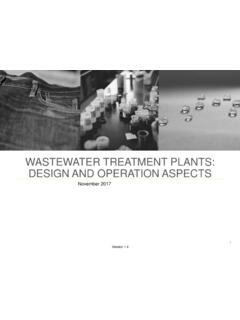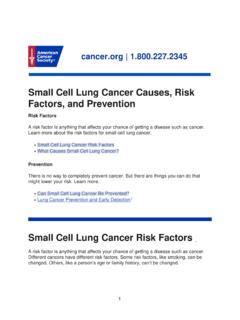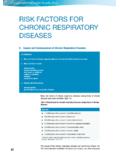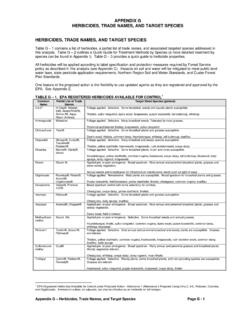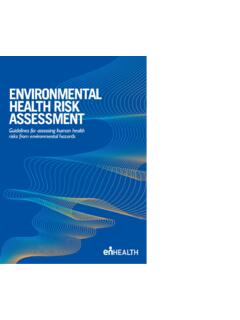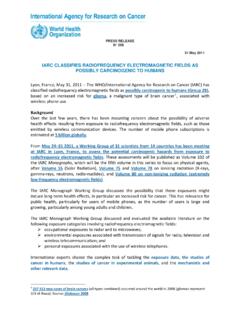Transcription of CHEMICAL RISK ASSESSMENT, HAZARD CONTROL AND …
1 1 CHEMICAL RISK assessment , HAZARD CONTROL AND EMERGENCY MANAGEMENTN ovember 20172 LEARNING OUTCOME & RESOURCESL earning Outcome Gaining knowledge on hazards , risks , exposures and effects of chemicals and how to assess these risks . Learning about CONTROL measures. Knowledge on how to prevent, prepare and respond to emergencies. Resources REMC Company Handbook. ZDHC CHEMICAL Management Systems Guidance Manual. ZDHC CHEMICAL Management for the Textile Industry, Module 2..WorkbookRefer to complimentary excercises in your workbook. 23 ZDHC REQUIREMENTSZDHC CMS - CHEMICAL Risk AssessmentZDHC CMS HAZARD and Risk assessment HAZARD and Risk assessment Inventory. ZDHC CMS -Environmental Process/Plan for reducing Environmental -Health and Safety Process/Plan for reducing Environmental Impact. Process for reducing Health and Safety Impacts (such as Action Plans). JSA with PPE for CHEMICAL Handling/Exposure.
2 A Job Safety Analysis (JSA) is one of the risk assessment tools used to identify and CONTROL workplace hazards . ZDHC CMS Emergency Procedures Process/Plan for reducing Environmental Impact. A process to identify and respond to potential CHEMICAL accidents. ZDHC CMS Safety Data Sheet Management Reference to recommended emergency D Risk assessment TemplateReference: ZDHC CHEMICAL Management Systems Guidance Manual34 THE PROBLEMWhat could occur if you are not aware of the risks from chemicals used in production? Brainstorm as a group and take notes in your workbook,exercise (11-1).5 hazards , risks , Exposures and Effects6 QUIZHow is risk defined?7 hazards , risks , EXPOSURES, EFFECTSHAZARDRISKA HAZARD is an intrinsic property of a CHEMICAL that is independent of usage, exposure or other criteria. Property examples: Gasoline is flammable. PCBs are persistent in the environment. Some uranium isotopes are risk also considers the exposure potential when using a CHEMICAL , the engineering controls in place, PPE, etc.
3 Thus, in general terms: Risk is a function of: HAZARDEXPOSURERISKT iger in a cageTiger in a cityReference: ZDHC CHEMICAL Management for the Textile Industry, Module 28 EXAMPLE: WORKER EMPTYING BAG OF UNHYDRATED LIMEH azards: Irritant to skin and eyes. Irritant to : Eye and skin contact with dust. Inhalation of : Blisters/burning of skins. Irritation/burning, including permanent damage to eye. Lung function impairment / burning to PATHWAYS (1/2)Exposure is the process of coming in contact with a PATHWAYSSale and use-phase Consumer and environment exposure (air, water, soil).Production Factory personnel exposure (manager, supervisor, worker, contractors).Transportation Interim handling personnel (transporters, customs officials, point of sale staff, etc.).Post-useSociety exposure (neighbourhood, downstream population).10 EXPOSURE PATHWAYS (2/2)EXPOSURE PATHWAYS11 EFFECTSE ffects, also known as HAZARD end-points, are the possible result of exposure to the Toxicity Human ToxicityExamples of HAZARD end-points: Irritation of skin, eyes and respiratory tract.
4 Narcosis and anesthesia. Systemic poisoning of liver, kidneys, nervous system and reproductive system. Cancer. Damage to the fetus. Genetic damage to following FACTORSCHEMICALHAZARDEXPOSUREEFFECTH azard level of substanceDose / concentrationDurationProbability severityOnce / several timesShort / long term13 FOCUS OF CHEMICAL HAZARD ASSESSMENTS ubstances of very High Concern (SvHC): When carcinogenic, mutagenic, toxic for reproduction, and/or persistent, bioaccumulativeand toxic (PBT). See lists under European REACH of High Concern (SHC).1314 ACTIVITY DISCUSSIONWhat chemicals with potential hazards can be found in wet-processing units? Discuss as a , exercise (11-2).15 Risk Management16 INFLUENCING FACTORSD oses / ConcentrationDurationProbability of adverse health effect1 spoonOnceLow20 spoonsOnce or twiceMaybe100 spoonsMore than twiceHighExample: Cooking saltLow RiskHigh RiskCHEMICALHAZARDEXPOSUREEFFECTHigh concentrationShort periodAcute (intermediate effects)Low concentrationLong periodMay result in even higher cumulative dose, resulting in chronic effectsBe aware of combined effects: Most common situation: workers exposed to two or more chemicals.
5 Challenge:the combined effects of chemicals is mostly unknown. Possible prevention: Avoid mixing several chemicals together. The combination may result in very dangerous effects.++==17 STARTING POINTS FOR RISK MANAGEMENTCHEMICALHAZARDEXPOSUREEFFECTH azard level of substanceDose / concentrationDurationProbability severityOnce / several timesShort / long term18 STARTING POINTS FOR RISK MANAGEMENTCHEMICALHAZARDEXPOSUREEFFECTH azard level of substanceDoses / concentrationDurationProbability severityOnce / several timesShort / long termUsing non or less hazardous chemicals19 STARTING POINTS FOR RISK MANAGEMENTCHEMICALHAZARDEXPOSUREEFFECTH azard level of substanceDose / concentrationDurationProbability severityOnce / several timesShort / long termEnclosed processesLocal exhaust ventilation (LEV)General ventilationPersonal protective equipment (PPE)20 STARTING POINTS FOR RISK MANAGEMENTCHEMICALHAZARDEXPOSUREEFFECTH azard level of substanceDoses / concentrationDurationProbability severityOnce / several timesShort / long termWork scheduling21 STARTING POINTS FOR RISK MANAGEMENTCHEMICALHAZARDEXPOSUREEFFECTH azard level of substanceDose / concentrationDurationProbability severityOnce / several timesShort / long term22 risks From Chemicals And Machinery Operated Processes23 QUIZWhy can the source of a CHEMICAL by a risk?
6 24 SOURCE OF CHEMICAL POSES risks ourceofchemicals: Manufacturedchemical. By-productfromanotherindustry. : Aceticacidmaybeaby-productfromthepharmac euticalindustryandcontainheavymetalsasim purities. CausticlyesourcedfromTyreindustrymaycont ainhighSulphidecontent. Ferroussulphatefromchemicalindustrymayco ntainhighamountsofMercury(Hg)andLead(Pb) . RecycledwoolmaycontainhighamountofPentac hlorophenol(PCP), FROM CHEMICALS RESIDUESR esidues: Materials which remain in a CHEMICAL and might result in positive CHEMICAL testing results against MRSL parameters. Subject to variation from batch to batch and manufacturer to manufacturer. Depend on the engineering controls used during manufacturing and chemicals management system available in place. FROM PROCESSES Chemicals react be aware that a process may have an influence on a CHEMICAL which support formation of hazardous chemicals. Improperorunstableprocessconditionsdurin gtheproductionmayleadtoformationofhazard oussubstances, Temperatureofcuringinprinting.
7 Timeofcuringandlamination. pHoftheprocess. Reductionclearingindyeing. Oxidationinvatdyeingandeffluenttreatment plant. DYINGP otentially, from Aniline: Potential occupational risks : Engage with CHEMICAL supplier and ask for change of solvent in dye manufacturing process. Adopt appropriate distillation process to completely recover residual nitrobenzene during the dyestuff manufacturing stage. 28 risks FROM POLYESTER DYING WITH DISPERSE DAYSP otentially,therecouldbeasmallresidueofp- nitrochlorobenzene(PNCB) :Incasethepolyesterfabricissubjectedtore ductionclearingprocessusingahighreducing agent(hydrose),thePNCB residuepresentinthedyestuffgetsalsoreduc edandgeneratesp-chloroaniline(PCA) from PCA: Skin sensitization. The substance may have effects on the risks : Select the dyestuff during the laboratory development or recipe selection stage which do not contain residual PCA or any possible amine generation due to process FROM YARN DYEING PROCESS Hazardous residue may be generated during the dyeing process.
8 Example:In package dyeing processes pressure vessels are used. Depending on the loading conditions (fully flooded or half flooded, air pad etc. ) the pressure and steam generated inside the dyeing vessel will vary. Certain dyes which are based on Tobias Acid or SulphonatedTobias Acid (which are common in some Red and Blue reactive dyes) may generate 2-Naphtylamine residue during the dyeing due to desulphonationprocess which is occurring due to the steam and pH conditions of the Tobias acid from 2-Naphtylamine: CancerMitigating risks : Avoid the use Tobias Acid or SulphonatedTobias Acid based dyestuff where dyeing process involving steam pressure. 2930 risks FROM PIGMENT PRINTING Hazardous residue may be generated during the pigment printing processExample: During the curing process, improper time and temperature conditions (along with moisture) could lead to formation of banned amines (2,4 toluenediamine, 4,4'-diaminodiphenylmethane) from cross-linkers/catalyst based on aromatic aziridinesor blocked aromatic isocyanates and also from CHEMICAL products based on aromatic from 2,4 Toluenediamine, 4,4 -Diaminodiohenylemethane: Repeated or prolonged contact may cause skin sensitization.
9 This substance is possibly carcinogenic to humans. May cause genetic damage in humans. Mitigating risks :Avoid the use of aromatic aziridinesor blocked aromatic isocyanates based crosslinking agent during printing and consider aliphatic Polyaziridinebased on casno. 64265-57-2 as a substitute. 31 RISK FROM WASTE WATER TREATMENT Hazardous residue may be generated during the water treatment : The effluent treatment plant does not follow a proper sequence of technologies, there could be a possibility of partial oxidation taking Generation from Wastewater Treatment:Generation of hazardous and eco toxic substances, such as NP from NPEO based product, nitrosamines from products containing secondary amine products also Cr (VI) generation from Total chromium present in risks : Ensure correct sequence of effluent plant technologies in place as required based on CHEMICAL residues released. Consider the retention times and CHEMICAL dosages -to ensure proper compliance at the discharge stage.
10 During the wastewater treatment these kind of detection is difficult to treat unless and until special treatment technologies are used which is applicable to only in few cases. Hence, it better to avoid use of products containing these risk during the production. follow the findings in your eco-mapsCross-link with other documentation ( using reference numbers) RE-CAP: DOCUMENT YOUR FINDINGS RISK INVENTORY ECO-MAPPINGR eference 33 Risk assessment Methods34 RISK assessment OF HAZARDOUS CHEMICALSWhen carrying out CHEMICAL risk assessment , several questions need to be asked: potential exposure may occur? Use CHEMICAL inventory, consider all persons who may be affected. Review PPE in use to make sure it is appropriate. Review environmental controls to ensure they are adequate. 2. What hazards are indicated for the chemicals? Information can be found on packaging labels, from SDS, supplier or a specialist in your factory.
